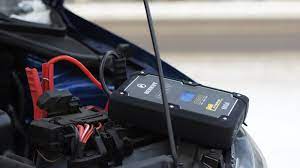
Types, device and principle of operation of the booster for starting the engine
Content
Many drivers in their practice faced battery discharge, especially in the winter season. The hooked battery does not want to turn the starter in any way. In such cases, you have to look for a donor for "lighting" or put the battery on charge. A starter-charger or a booster can also help solve this problem. It will be discussed later in the article.
What is a starter-charger
A starter-charger (ROM) helps a dead battery to start the engine or replaces it completely. Another name for the device is "Booster" (from the English booster), which means any auxiliary or amplifying device.
I must say that the very idea of starting-chargers is completely new. Old ROMs, if desired, could be assembled with your own hands. But these were bulky and heavy vehicles. It was extremely inconvenient or simply impossible to carry it with you all the time.
That all changed with the advent of lithium-ion batteries. Batteries made using this technology are used in modern smartphones and other digital technology. We can say that with their appearance there was a revolution in the battery field. The next stage in the development of this technology was the emergence of improved lithium-polymer (Li-pol, Li-polimer, LIP) and lithium-iron-phosphate batteries (LiFePO4, LFP).
Power packs often use lithium polymer batteries. They are called "power" due to the fact that they are capable of delivering a large current, several times higher than the value of their own capacity.
Lithium iron phosphate batteries are also used for boosters. The main difference between such batteries is a stable and constant voltage at the output of 3-3,3V. By connecting several elements, you can get the desired voltage for the car network of 12V. LiFePO4 is used as the cathode.
Both lithium polymer and lithium iron phosphate batteries are compact in size. The thickness of the plate can be about a millimeter. Due to the use of polymers and other substances, there is no liquid in the battery, it can take almost any geometric shape. But there are also disadvantages, which we will consider later.
Types of devices for starting the engine
The most modern are considered to be battery-type ROMs with lithium-iron-phosphate batteries, but there are other types. In general, these devices can be divided into four types:
- transformer;
- condenser;
- impulse;
- rechargeable.
All of them, one way or another, provide currents of a certain strength and voltage for various electrical engineering. Let's consider each type in more detail.
Transformer
Transformer ROMs convert the mains voltage to 12V / 24V, rectify it and supply it to the device / terminals.
They can charge batteries, start the engine, and also be used as welding machines. They are durable, versatile and reliable, but require a stable mains voltage. They can start almost any transport, up to a KAMAZ or an excavator, but they are not mobile. Therefore, the main disadvantages of transformer ROMs are large dimensions and dependence on the mains. They are successfully used at service stations or simply in private garages.
Condenser
Capacitor starters can only start the engine, not charge the battery. They work on the principle of impulse action of high-capacity capacitors. They are portable, small in size, charge quickly, but have significant drawbacks. This is, first of all, danger in use, poor maintainability, poor efficiency. Also, the device is expensive, but does not give the expected result.
Impulse
These devices have a built-in high-frequency inverter. First, the device raises the frequency of the current, and then lowers and straightens, giving the output the required voltage for starting the engine or charging.
Flash ROMs are considered a more advanced version of conventional chargers. They differ in compact dimensions and low cost, but again there is not enough autonomy. Access to mains is required. Also, impulse ROMs are sensitive to temperature extremes (cold, heat), as well as to voltage drops in the network.
Rechargeable
We are talking about battery ROMs in this article. These are more advanced, modern and compact portable devices. Booster technology is advancing rapidly.
Booster device
The starter and charger itself is a small box. Professional models the size of a small suitcase. At first glance, many doubt its effectiveness, but this is in vain. Inside is most often a lithium iron phosphate battery. The device also includes:
- electronic control unit;
- protection module against short circuit, overload and polarity reversal;
- mode / charge indicator (on the case);
- USB inputs for charging other portable devices;
- flashlight.
Crocodiles are connected to the connector on the body to connect to the terminals. The converter module converts 12V to 5V for USB charging. The capacity of a portable battery is relatively small - from 3 A * h to 20 A * h.
Principle of operation
Let us recall that the booster is capable of short-term delivery of large currents of 500A-1A. Usually, the interval of its application is 000-5 seconds, the duration of the scrolling is no more than 10 seconds and no more than 10 attempts. There are many different brands of booster packs, but almost all of them work on the same principle. Let's consider the operation of the "Parkcity GP5" ROM. This is a compact device with the ability to charge gadgets and other devices.
ROM operates in two modes:
- «Start Engine»;
- «Override».
The "Start Engine" mode is designed to help a battery that has run down, but not completely "dead". The voltage limit at the terminals in this mode is about 270A. If the current rises or a short circuit occurs, the protection is immediately triggered. A relay inside the device simply disconnects the positive terminal, saving the device. The indicator on the booster body shows the state of charge. In this mode, it can be safely used multiple times. The device should easily cope with such a task.
Override mode is used on an empty battery. After activation, the booster starts to work instead of the battery. In this mode, the current reaches 400A-500A. There is no protection at the terminals. A short circuit should not be allowed, so you need to tightly connect the crocodiles to the terminals. The interval between applications is at least 10 seconds. The recommended number of attempts is 5. If the starter turns, and the engine does not start, then the reason may be different.
It is also not recommended to use the booster instead of the battery at all, that is, by removing it. This can damage the electronics of the car. To connect, it is enough to fix the crocodiles in the plus / minus sequence.
There can also be a Diesel mode, which provides for the preheating of the glow plugs.
Advantages and disadvantages of boosters
The main feature of the booster is the battery, or rather, several batteries. They have the following advantages:
- from 2000 to 7000 charge / discharge cycles;
- long service life (up to 15 years);
- at room temperature, it loses only 4-5% of its charge per month;
- always stable voltage (3,65V in one cell);
- the ability to give high currents;
- working temperature from -30 ° C to + 55 ° C;
- mobility and compactness;
- other portable devices can be charged.
Among the disadvantages are the following:
- in severe frost, it loses capacity, especially lithium-ion batteries, as well as smartphone batteries in frost. Lithium iron phosphate batteries are more resistant to cold;
- for cars with an engine capacity of more than 3-4 liters, a more powerful device may be needed;
- quite high price.
In general, devices such as modern ROMs are useful and necessary devices. You can always charge your smartphone or even use it as a full-fledged power source. In a critical situation, it will help to start the engine. The main thing is to strictly observe the polarity and the rules for using the starting-charger.

